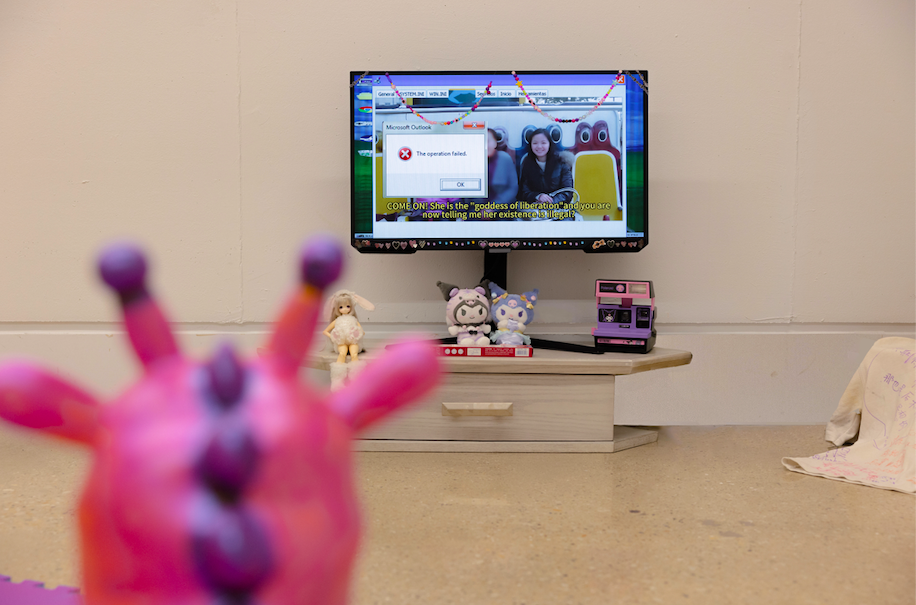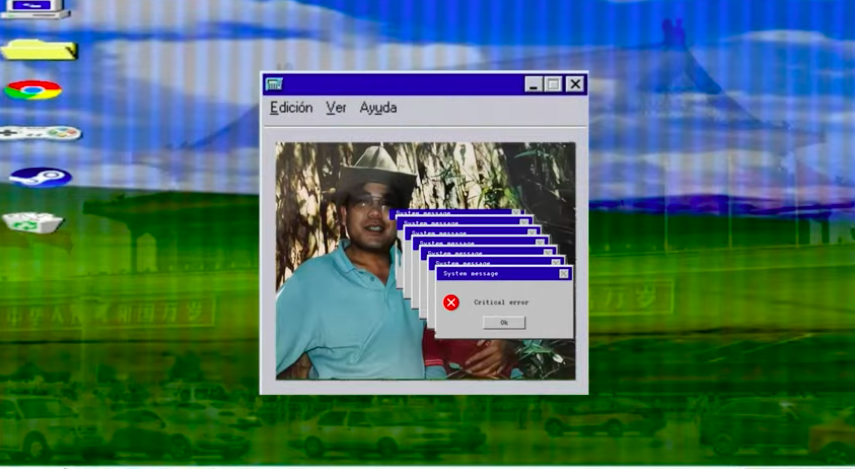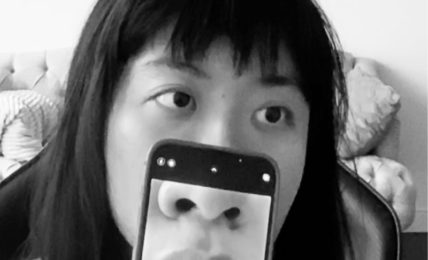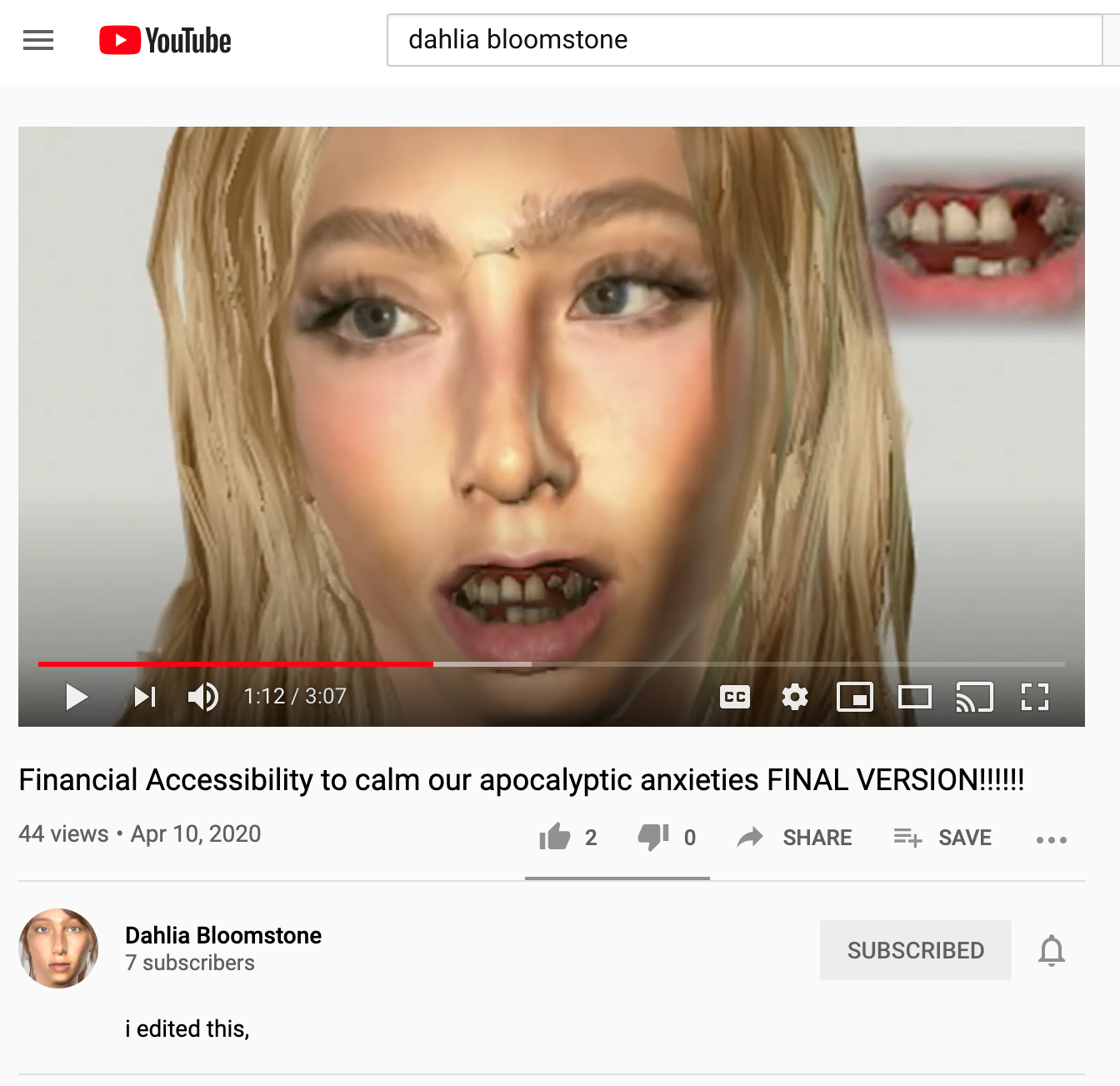Digital America interviewed Zhuoyu Zhang in April of 2025 on her work Dolma.
:::

:::
Digital America: Dolma (2023) is a nostalgic, but blurred self-portrait constructed through childhood memories, images, and audio. You use the term “cosmopolitan refugee” to describe your position. How do you define this identity? How has this identity shaped your relationship with home, memory, and art?
Zhuoyu Zhang: The term “cosmopolitan refugee” was something I created while creating Dolma (2023). It speaks to a generation like mine—those raised in the wake of millennial waves of cross-cultural flux, who drift between places and identities, often finding no clear sense of belonging, either geographically or emotionally. We are transient inhabitants of Earth, constantly breaking and reassembling the contours of the self as we move, adapt, and rebuild—shaping a blurry identity, but no less real.
While I use the term “refugee” in a metaphorical and emotional sense, I’m mindful of its political weight. I’m not referring to displacement caused by war or persecution, but rather to a quieter, psychological kind of rootlessness—one shaped by mobility, privilege, and soft instability. What began as a personal reflection has become a lens through which I see a broader condition. In the wake of globalization, many people of my generation have grown up navigating multiple cultural systems, shifting geographies, and layered emotional registers.
To me, the idea of “home” has long outgrown any fixed geographical coordinate. It feels more like a mirage—an emotional projection, a flicker of hope glimpsed by a desert traveler, or a distant shore that remains forever unreachable to one adrift at sea. Home has become a kind of hopium, a longing shaped by displacement and continually beautified through the lens of absence.
In parallel, our understanding of memory, especially in a digital age saturated with social media and constant documentation, has become increasingly unstable. Memory no longer functions like a hard drive retrieving precise data; it is now a process of constant reconstruction, shaped by emotional residues and external influences. We craft narratives in diaries no one reads, and we edit images to curate our digital selves on social media platforms. In this process of manipulation, beautification, and erasure, memory becomes less about accuracy and more about performance—a stage upon which the self is perpetually rewritten.
While working on Dolma, I began to recognize that what I carry isn’t just personal recollection, but something closer to what scholar Marianne Hirsch terms postmemory—the inherited memories of traumatic pasts we might not have lived through, but which were transmitted to us through fragments of voice, gestures, and unspoken stories. These are not memories in the traditional sense, but deeply felt emotional imprints—so fully internalized they become indistinguishable from lived experience.
In Dolma, I respond to these inherited fragments by deconstructing them: transforming voicemails, childhood objects, and family photographs into a visual and sonic collage that speaks not just to my own story, but to a shared diasporic condition. This pattern of migration, adaptation, and reconstruction permeates my practice. Dolma is a blurred self-portrait told through deconstructed memory—a diaristic mapping of place, loss, and longing. It is at once intimate and collective: a fragmented narrative of remembrance, shaped not by facts, but by feelings of displacement, of nostalgia, and of becoming.
DigA: Dolma has a narrative style that’s witty, incoherent, and chaotic, and memories emerge in a non-linear expression, such as popped-up windows and pixelated games. Did you intend to create this style initially or did it evolve as you brought in different themes? How do these outdated digital elements affect the emotion of the work?

ZZ: The visual and narrative style of Dolma—its chaos, incoherence, and layered nostalgia—was not accidental. It was something I had long envisioned, even before the project formally took shape. I’ve always been drawn to the digital aesthetic now referred to as Frutiger Aero. It dominated the visual culture of the mid-2000s to early 2010s: gradients, aqua buttons, blue skies, water reflections, lens flares, tropical fish—all symbols of a strangely optimistic techno-future.
This aesthetic didn’t emerge in a vacuum. It followed the collective anxiety of the Y2K crisis, a moment when people feared that a simple date formatting glitch might trigger digital collapse. When that apocalypse didn’t come, there was a palpable sense of relief, even euphoria. Early 2000s design captured this techno-optimism: a belief that digital life could be bright, soft-edged, and human-friendly.
In contrast, today’s interfaces feel colder, flatter, and more corporate. There’s a growing skepticism toward technology—toward AI, surveillance, algorithmic control. We’ve begun to interrogate the cost of convenience: the surrender of agency, memory, and control. In that context, the resurgence of “outdated” digital elements—pixel games, pop-up windows, low-res icons—feels like more than just aesthetic recycling. It’s a way of re-establishing intimacy with an earlier digital era, one that felt less extractive, more tactile, more emotionally anchored.
For me, these outdated visuals are not just nostalgic props; they act as emotional cues. They evoke a kind of temporal dissonance—a space where viewers might feel comfort without fully returning, remembering without needing to reconstruct. Dolma leans into that emotional friction. The glitches, pop-ups, and incoherent navigation echo the instability of memory itself: fragmented, reloaded, and always under construction. Its non-linear structure—scattered voicemails, floating images, layered memories—mirrors the fractured way identity often forms in those who grow up between languages, locations, and cultural expectations.
DigA: You use floating fonts, pop-ups and dialog box overlaps in your work, which (speaking as a viewer) are impactful and affective—as though those digital elements are reflecting your inner worlds. How do you see the relationship between information overload and self-expression in the digital age? Are these chaotic visuals also a presentation of your inner states?
ZZ: As a Gen Z internet addict, I spend most of my time navigating across endless tabs, platforms, and algorithmic feeds. This kind of digital experience is rarely linear. Everything feels overlapping, glitchy, fast, and loud. After a while, it becomes difficult to hold focus or process anything deeply. There’s a term for that: attentional fragmentation. It happens when your brain gets overstimulated by too much input and short-circuits its ability to filter, prioritize, or stay focused.
In moments like that, my emotions begin to resemble a task manager interface. Multiple feelings—joy, anxiety, frustration, nostalgia—open like parallel apps. None of them get properly processed, so they hover like system warnings, forming a background network of unresolved states. That inner chaos eventually leaks into the visual field: dialogue boxes that won’t close, floating fonts, overlapping windows asking for attention. Dolma draws directly from this experience.
While working on the piece, I was overflowing with ideas. Sometimes there were too many to keep up with. My thoughts moved faster than I could write, code, or compose. It felt like my brain’s GPU was being overclocked, overheating from the inside with too many emotional tabs running at once. The pop-ups, flickering interfaces, and overlapping voices in Dolma are not just stylistic references. They are emotional metaphors that reflect what it feels like to live, think, and create inside an overstimulated digital nervous system. Some of these ideas echo questions from migration studies, like how repeated relocation and cultural shifts affect identity formation and social integration. But my work remains grounded in lived emotion and subjective memory rather than broad theoretical claims.
DigA: “Millennial memes” have been a hot topic on the East Asian Network, with many people reminiscing and longing for that era. Can you talk about your impression of “millennial memes” and nostalgia in digital art?
ZZ: When I think of millennial memes, I picture a flood of low-resolution, pixelated images, often stamped with layers of autogenerated watermarks from endless re-sharing. Some came from early internet forums like 2chan or Baidu Tieba, and video platforms like Nico Nico Douga, where users would splice together faces, text, and pop culture images to create chaotic humor. Others were stills from TV dramas or variety shows, repurposed and remixed until they became cultural shorthand. These memes weren’t clean or polished. Their grainy, glitchy look was part of the point.
What fascinates me is how people today are still recreating that exact aesthetic. There are even “watermark overlay generators” now that simulate the messy, recursive logic of those old images. It’s like users are collectively reconstructing the aesthetic residue of an era. To me, these digital leftovers — the compression artifacts, the broken fonts, the accidental compositions — act as emotional fossils. They show us how content circulates, how it decays, and how it survives.
Artist and theorist Hito Steyerl talks about this in her essay In Defense of the Poor Image. She describes low-quality images not as degraded, but as evidence of circulation. The poor image, she writes, “is a ghost of an image, a preview, a thumbnail, an errant idea, an itinerant image.” It lives in motion, passed from screen to screen, losing clarity but gaining presence.
In digital art, nostalgia tends to operate similarly. It isn’t clean or restorative. It’s more like a lingering process, like something stuck in your system’s cache that keeps resurfacing. These images don’t take us back to the past so much as they remind us that the past never really leaves. They flicker in and out, reappearing in unexpected forms, like a memory you didn’t mean to keep but somehow can’t delete. In that sense, nostalgia becomes a tool, not to preserve the past, but to interrupt the present with traces of what still haunts it.
DigA: What are you working on now?
ZZ: Lately, I’ve been working on a project called OPTOUT.IO, an interactive game in the form of a visual novel. It explores the illusion of choice within algorithmic systems—the sense that you’re making decisions, when in fact everything has already been quietly shaped by invisible structures. For me, it returns to questions I keep circling around: digital anxiety, identity drift, and emotional overload. This time, though, they unfold through branching narratives and an animated visual style.
I’ve always been drawn to the idea of coexisting with things we can’t quite grasp—memory, nostalgia, or the systems we live in but don’t fully understand. OPTOUT.IO is still in progress, and I’m figuring things out as I go. Hopefully, it’ll be ready to share soon. I’m especially curious to see how others move through it and shape their own version of the experience.
:::
Check out Zhuoyu Zhang’s work Dolma.
:::




